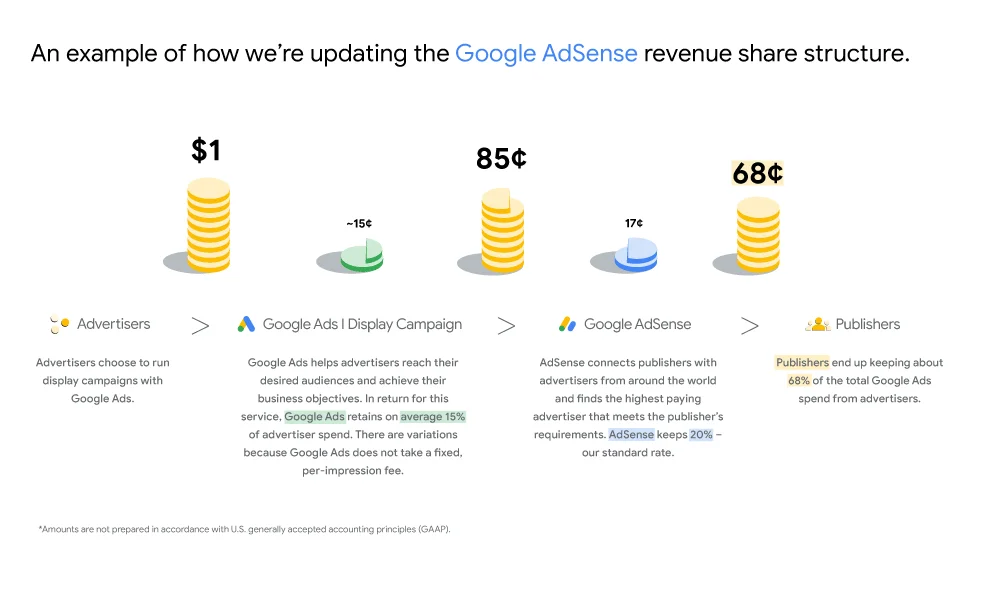Google AdSense, the world’s most popular online advertising platform, announced two major updates in 2024: a move to a CPM (cost-per-mille) pricing model and a revamp of its revenue share model. These changes will have a significant impact on publishers, both positive and negative.
Contents
Google AdSense announced a significant shift in its revenue share model, moving from a unified percentage to separate rates for buy-side and sell-side transactions:
- Google Ads buy-side: Google Ads will take its average 15% cut, leaving the publisher with the remaining 68%. This scenario remains largely unchanged from the previous model.
- Third-party platform buy-side: Here, the publisher receives 80% after the third-party platform deducts its fee. Google is not involved in this transaction and has no visibility into the platform’s fees.

What this means for publishers?
- Increased complexity: Navigating different fee structures from various buy-side platforms requires closer attention to ad performance and cost analysis.
- Greater transparency: This split provides publishers with clearer insight into their revenue streams, allowing them to track the impact of different buy-side partners.
- Potential for optimization: With deeper insights into buy-side fees, publishers can strategically choose platforms and optimize their ad mix for higher revenue.
2. Update on the move from CPC to CPM
Google AdSense previously used a CPC (cost-per-click) pricing model, in which publishers only receive money when a user clicks on an ad. With a CPM pricing model, publishers will receive money for every 1,000 impressions of an ad.
It’s important to note that this change will not influence the type or quantity of ads publishers can display on their websites.
Google Blog: Updates to how publishers monetize with AdSense
What can publishers expect from this change?
- High-Traffic Boom: CPM rewards impressions, not clicks, meaning websites with bustling visitor counts can finally monetize their audience in a big way. Every eyeball becomes a potential revenue stream, making CPM ideal for content powerhouses and traffic magnets.
- Brand Bonanza: Say hello to a wider pool of advertisers! CPM attracts brands seeking broad exposure and top-of-mind awareness. This opens doors to lucrative partnerships with companies willing to pay for eyeballs, not just clicks, potentially boosting your overall ad revenue.
- Learning Playground: Even fledgling advertisers find CPM alluring. The impression-based model provides valuable data on clicks, landing page effectiveness, and user engagement. This allows advertisers to optimize their campaigns with every impression, making it a win-win for both publishers and brands.
- Demand Surge: Buckle up for increased competition! With brands and advertisers vying for your audience’s attention, CPM naturally drives up demand for your ad space. This translates to potentially higher bids and even better revenue for you.
- Transparency Triumphs: CPM puts you in control. You see exactly how much each impression earns, offering unparalleled transparency into your ad revenue streams. This empowers you to make informed decisions about content, ad placement, and even negotiating better deals with advertisers.
3. How can publishers maximize the benefits of the move to a CPM pricing model?
- Optimize your content and website: Ensure that your content and website are engaging and relevant to your target audience. This will help you attract more advertisers and increase advertising revenue.
- Compare CPM rates from different advertising platforms: Compare CPM rates from different advertising platforms to ensure that you are receiving the best possible rate. In this situation, PubPower is a comprehensive solution for them. PubPower allows publishers to add all of their existing demand sources, including Google Adsense, to the system to compete directly with PubPower’s available demand (30+ DSPs, SSPs, and Ad exchanges from around the world) via bid auction. This allows publishers to compare the CPM price between Adsense and multiple ad networks in real-time, and maximize their ad revenue by selling their inventory to the one who pays the highest price in the bid auction.
- Track the performance of your ads: Use analytics tools to track the performance of your ads. This will help you better understand your audience and adjust your advertising strategy accordingly.
The move to a CPM pricing model by Google AdSense is a significant change for publishers. Publishers can maximize the benefits of this change by optimizing their content and website, comparing CPM rates from different advertising platforms, and tracking the performance of their ads.
If you are a publisher, start preparing for this change today. Optimize your content and website, compare CPM rates from different advertising platforms, and start using analytics tools from PubPower to track the performance of your ads effectively.



